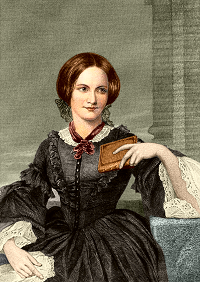
Charlotte was the third of six children. When the girl was five years old, her mother passed away, and her aunt Elizabeth Branwell moved into their rectory to look after the orphaned children. When Charlotte was eight years old, her two older sisters, Maria and Elizabeth, died of consumption. This event made Charlotte responsible for the family, and the oldest of the remaining four children, which strengthened her personality and spirit.
Charlotte Bronte was short, frail, and wore glasses to correct her nearsightedness, and considered herself plain. She was a political conservative, strict, intelligent, and ambitious. She had high moral principles, and despite her modest behavior in society, she was always ready to defend her point of view.
The writer spent eight months in 1824 at the Clergy Daughters school, in the village of Cowan Bridge, which served as the prototype of the Lowood school in the novel Jane Eyre. She then spent two years as a pupil at Roe Head School in Dewsbury, West Yorkshire, and worked as a teacher there for another three years. It was at Roe Head where she met two loyal friends-Ellen Nassi and Mary Taylor. Then, in 1842-1843, she was in the boarding house of Madame Heger (Brussels), where she fell in love with her own teacher, Constantin Heger. Between 1824-1831, she and her siblings were homeschooled by her father and Aunt Branwell. Charlotte was a great artist, needlewoman, and, of course, a writer.
Mrs. Bronte wanted her daughters to be governesses. Charlotte changed two jobs — for three months (in 1839), she lived with the Sidwick family in Stonegape, in the locality of Loserdale. She then spent six months with the White family at Upperwood House in Rawdon. Charlotte did not like her job, and suggested for the three sisters, Emily and Anne, to open their own school in Haworth. Aunt Brenwell wanted to arrange the material side of the case, but these plans never came to fruition.
In 1846, Charlotte persuaded her sisters to publish a collection of poems under the male pseudonyms Currer, Ellis, and Acton Bell — a commercial failure. However, by the end of 1847, the debut novels of all three sisters were published, and "Jane Eyre" by Charlotte Bronte was expected to be an incredible success.
After the publication of the book "Shirley" in 1849, rumors began to spread that a simple teacher was hiding under the male pseudonym Currer Bell. Charlotte became a celebrity in literary circles, and the publication of the novel "Villette" in 1853 only strengthened her reputation.
In December 1852, Charlotte receives a marriage proposal from the vicar (second priest of the parish) of her father, Arthur Bell Nicholls. Charlotte's father was opposed to this union, partly because he considered her too sickly to bear a child and give birth to it without terrible consequences, and so as not to upset her father, Charlotte refused Arthur. Despite this, Bell Nicholls did not give up, and continued the courtship, and eventually the couple married on June 29, 1854. The marriage was happy, but very short. Charlotte Bronte died in the last stage of pregnancy on March 31, 1855.
NaziraArtykbayeva, librarian of the International Book Department

